Microsoft Build 2018, the company's flagship developer conference, packed a lot of news into a few days. With dozens of announcements, including 70 new capabilities in Azure and more than 100 new features for the Bot Framework, it's impossible to capture even all of the important ones from the Seattle event.
What follows are 12 key takeaways from the three main keynotes last week that highlight important trends and opportunities for Microsoft partners.
1. Microsoft 365 Gets Promoted
It's been clear for a long time that Azure is the key strategic umbrella platform for Microsoft. The question is, how does Microsoft prioritize and organize the rest of its products? At least for Build, Microsoft CEO Satya Nadella made that clear.
"We're focused on two massive platform opportunities -- one, Microsoft Azure, the other Microsoft 365," Nadella said in his kickoff keynote.
The designation of Microsoft 365 up alongside Azure is a significant elevation or promotion for Microsoft 365, which previously seemed more like a licensing construct rather than an organizing principle for Windows 10, Office 365 and Enterprise Mobility and Security (EMS) Services.
Joe Belfiore, corporate vice president for Windows at Microsoft, expanded on the architectural vision around Microsoft 365 in his Day 2 keynote. "We want Microsoft 365 to embrace multiple devices. We want it to be smart about letting users move from a PC to a phone. We want Microsoft 365 to embrace multi-sense use. We want it to be able to fluidly go from mouse and keyboard to touch to ink. We want to be embracing vision, new ways of working like wearing a VR display, and so a lot of these ideas are not only work that we're doing in the products that we build, but we're also trying to platformize so the code that all of you build will make your organizations more effective in the same kind of way," Belfiore said.
Short version, pay attention to Microsoft 365 as a platform.
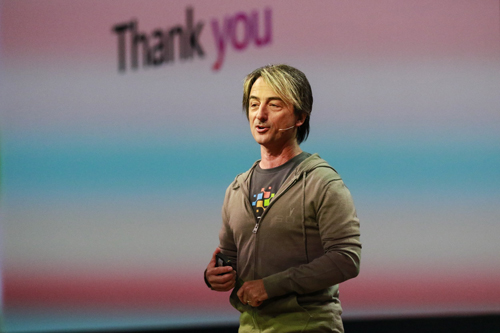 Joe Belfiore detailed Microsoft's vision for Microsoft 365 during his Day 2 Build keynote. (Source: Microsoft)
Joe Belfiore detailed Microsoft's vision for Microsoft 365 during his Day 2 Build keynote. (Source: Microsoft)
2. Azure is Accelerating
Microsoft's big ambitions for Azure itself are expanding. Nadella laid out Microsoft's grandiose plans rather bluntly.
"Azure is being built as the world's computer," Nadella said.
He marshalled a fair amount of evidence for the assertions around Azure's scale:
- There are more than 50 regions.
- The Azure cloud counts 70-plus certifications worldwide.
- About 70 new Azure capabilities were launched during Build.
Nadella also enumerated all the ways the platform is expanding beyond the core public cloud service: "As computing spreads, as there is need for computing at the edge, we are building out Azure, Azure Stack, Azure IoT Edge and Azure Sphere as this one computing fabric that supports this new application model."
That intelligent edge emerged as an important theme at Build, and Microsoft also spent some time clarifying use cases for Azure Stack, the private cloud version of Azure that a company can run in its own datacenter disconnected from the public cloud. Azure Stack is not just, or even primarily, about organizations that distrust public cloud networks. Instead, Microsoft is positioning Azure Stack as a prime example of the intelligent edge.
"Azure Stack, which is just a year old, is supporting multiple scenarios. For example, Chevron is using it so that they can essentially have Azure in a disconnected way at their oil rigs. A bank in South Africa, ABSA, is using it for their regulatory workloads, as well as using the public cloud, Azure. And then Schlumberger is actually doing distributed computing. So they use the public cloud, as well as Azure Stack, as one fabric to be able to distribute compute so that it's close to where the data is," Nadella said.
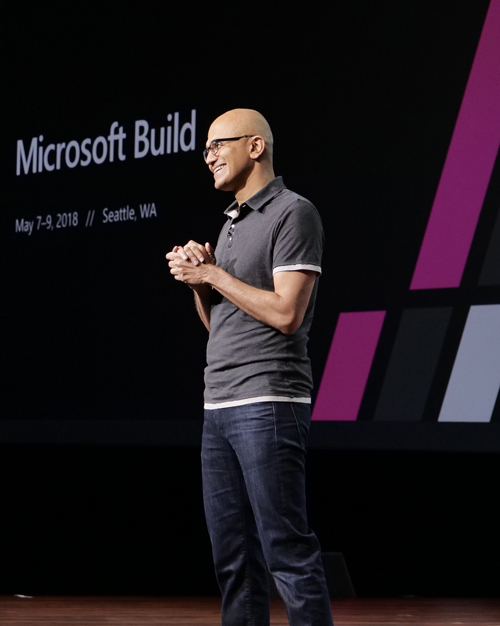 Microsoft CEO Satya Nadella enumerated all the ways the Azure platform is expanding beyond the core public cloud service. (Source: Microsoft)
Microsoft CEO Satya Nadella enumerated all the ways the Azure platform is expanding beyond the core public cloud service. (Source: Microsoft)
3. Commoditizing AI
Closely linked to Azure is artificial intelligence, and AI was a huge theme at Build.
Nadella reeled off a number of milestones Microsoft had achieved comparing machine performance versus human performance on various tasks, but then put them in a perspective that demonstrated Microsoft's AI philosophy.
"Who cares about breakthroughs we achieve? What matters is can we translate these into frameworks, tools and services, and put them in your hands as developers so that you can take AI and have impact in every industry in every application. That's what's important. We truly are committed to, in some sense, commoditizing AI," Nadella said.
Among the more specific AI announcements during Build week, one significant enhancement was a preview of Project Brainwave, a distributed, real-time AI fabric that currently works with FPGAs from Intel.
4. 200 Million Corporate Users of Windows 10
Belfiore shared Windows 10 deployment momentum numbers that show Microsoft's flagship client OS gaining traction among business users.
"We see Windows 10 deployment really ramping up significantly in commercial accounts. Right now there are over 200 million people in corporate accounts using Windows 10 and we've seen that adoption rate increase now at 79 percent year-over-year growth," Belfiore said.
5. Sweetening the Pot at the Microsoft Store
The Microsoft Store will offer a better deal to development partners creating consumer apps.
Belfiore announced a change in the revenue model within the store for consumer apps.
"If you're somebody who writes consumer apps -- not games, not commercial apps -- you care about the fact that going forward later this year, we will increase the revenue share to 85 percent of the revenue going to you if someone comes to the Microsoft Stores, finds your app and installs it," Belfiore said.
The deal will be even better for partners running their own campaigns or promoting the apps on their own Web sites. "If you send a customer to the Microsoft Store and they find your app, we'll return 95 percent of the revenue to you, making this the most developer-friendly store from an economic point of view of all the large ecosystems," he said.
6. Bring Out the Drones
A big theme at Build was enabling developers to create solutions combining Internet of Things, Azure cloud, AI, cameras and drones.
Sam George, director of Azure IoT engineering and program management at Microsoft, oversaw a keynote demo of a drone visually inspecting pipes for damage.
"For the first time ever, we're able to stream video back from that drone to this laptop running IoT Edge and our AI model, which was developed in the cloud," George said.
Major related news at the show included camera partnerships with Qualcomm, a drone-related partnership with DJI and the revival of Kinect, Microsoft's groundbreaking motion sensor for gaming as an IoT device.
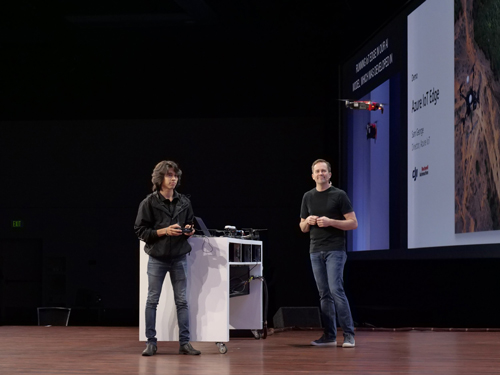 [Click on image for larger view.] Executives from Microsoft and DJI gave a demo of new technology being used in drones. (Source: Microsoft)
[Click on image for larger view.] Executives from Microsoft and DJI gave a demo of new technology being used in drones. (Source: Microsoft)
7. New Tricks for Cortana
The Microsoft digital assistant Cortana was a star of the show, most visibly in an on-stage demo with Amazon Alexa. The two assistants called upon one another to handle tasks in their specialty areas, with Alexa focusing on home and consumer jobs and Cortana handling work schedules and e-mails.
Tom Taylor, a senior vice president for Amazon Alexa, had one of the best applause lines of the show when he asked Alexa: "What do you think about Cortana?" Alexa replied: "I like Cortana. We both have experience with light rings, although hers is more of a halo."
A significant theme around Cortana was the emergence of the personification of AI as Cortana-based assistance versus being an assistant.
In that vein and around the broader enablement of chats and bots, Nadella said, "At this conference, we're launching 100-plus new features for the Bot Framework so that you can continue to build these conversational interfaces and give them more of the customization. So, for example, you can have a custom wake word, you can give it custom speech, you can even give it custom personality, take some of the FAQs and turn them into Q&A. And then take the corpus of data you have in terms of conversations and use that as label data to have a full dialogue system."
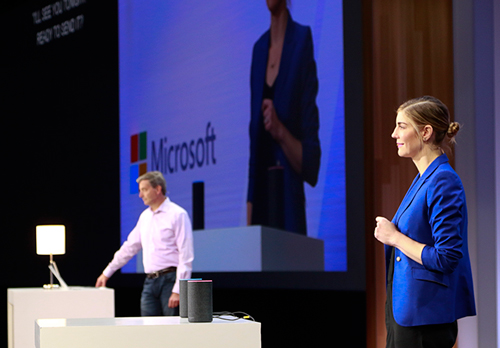 Megan Saunders of Microsoft and Tom Taylor of Amazon demo the limited beta version of Cortana-Alexa integration. (Source: Microsoft)
Megan Saunders of Microsoft and Tom Taylor of Amazon demo the limited beta version of Cortana-Alexa integration. (Source: Microsoft)
8. Open Source Love Continues
Microsoft can't get developers together anymore without professing its undying commitment to open source in some way.
This time it took the form of a testimonial from Jason Warner, the senior vice president of technology at GitHub, who took the keynote stage to talk about the scale of Microsoft's efforts on GitHub.
"I think it's amazing to see what Microsoft has done in the past few years," Warner said. "The industry has shifted, and they realize the power of open source. And, in fact, I don't think it's too bold to say that open source now powers modern software development. And Microsoft might be the best example of a corporation embracing open source. We know from statistics that we have in GitHub that Microsoft is the single largest corporate contributor to open source on GitHub, and there by extension, in the history of open source. In fact, Microsoft has the largest open source community in the entire world with Visual Studio Code."
In a slide at the show, Microsoft boasted that in 2016, it was the top open source project contributor on GitHub with 16,419 contributors.
Microsoft also currently says that 40 percent of Azure Virtual Machines run Linux.
9. Expanding the Container Story
Microsoft used Build to disclose a further push into the world of containers, with the announcement of the Azure Kubernetes Service.
"Our new AKS, or Azure Kubernetes Service, provides a fully managed Kubernetes-based orchestration service. It provides built-in auto-patching, auto-scaling and update support, which enables you to take the full-breadth of the Kubernetes ecosystem when you're doing your development," Guthrie said.
10. Partner Azure Co-Sell Program Driving Revenue
An Azure co-sell program that gives Microsoft field sellers special incentives to promote partner solutions with customers is getting traction.
"This program continues to grow beyond expectation, delivering over $2.3 billion in partner revenue to date," said Charlotte Yarkoni, Microsoft's corporate vice president of growth and ecosystem.
The co-sell programs connects startups and other partners to enterprise customers through Microsoft's worldwide salesforce and channel. The program was launched at the Microsoft Inspire partner conference in July. It includes funding from Microsoft to pay its own sales reps up to 10 percent of the partner's annual contract value when they co-sell qualified Azure-based partner solutions.
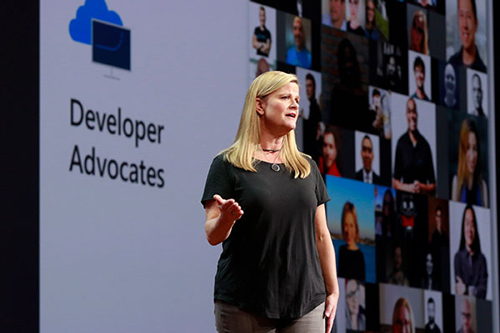 Charlotte Yarkoni, Microsoft's corporate vice president of Growth and Ecosystem, said at Microsoft Build 2018 that the Azure co-sell program delivered $2.3 billion in partner revenues. (Source: Microsoft)
Charlotte Yarkoni, Microsoft's corporate vice president of Growth and Ecosystem, said at Microsoft Build 2018 that the Azure co-sell program delivered $2.3 billion in partner revenues. (Source: Microsoft)
11. Get To Know the Graph
Alongside the rise of Microsoft 365 comes the rise of an underlying technology called the Microsoft Graph.
Belfiore called the Graph one of the most important things that Build attendees should understand for his Microsoft 365-focused Day 2 keynote.
"I just want you to come into the keynote with one key idea, which is that the Graph is a cloud-backed data store where both you and us can put organizational data in a way that's private an secure to the organization, but in a way that also lets our solutions take advantage of both so that AI can reason against that data, that organizational data, and so that the experiences that both we build and you build can light up and make those end users lives better," Belfiore said.
Many of the announcements and demos during the keynote related to the Graph. Notable ones included Timeline, a technology that lets users scroll back through their history of activities with the ability to click on entries to pick up where they left off. A related concept was Sets, which could also be accessed through the Timeline, but which allow users to bring up the entire context of a project, such as a Word document with the associated browser tabs that were being used in researching the document.
12. Laying Down a Responsibility Marker
In an era when Facebook executives are testifying before Congress and cable news shows feature constant discussion about technology's role in democratic elections, Nadella laid down a marker on responsibility.
"We...have a responsibility as a tech industry to build trust in technology," Nadella said right at the start of his Build keynote. Echoing recent comments from Microsoft President Brad Smith, Nadella said Microsoft is focused on three core pillars: privacy, cybersecurity and ethical AI.
Posted by Scott Bekker on May 14, 20180 comments
Microsoft released a new offering through its Cloud Solution Provider (CSP) program on Thursday that could help partners create more cost-effective Microsoft Azure solutions for customers willing to pay upfront.
Azure was already available through CSP, which is Microsoft's program allowing partners to resell cloud services and other Microsoft products to customers on a subscription basis. The bulk of Microsoft and partner business in CSP is in Office 365, but Microsoft has been steadily adding other products and services to the mix.
Because pricing of Azure can be high for customers paying on an as-you-go, monthly basis, Microsoft in March unveiled an Azure Reserved Virtual Machine Instances (RI) option for companies purchasing predictable workloads. Azure RI is a one- or three-year pre-purchase of cloud compute resources, which can be scaled up with an additional payment or scaled down or cancelled with a refund as requirements evolve.
According to Microsoft, the total savings for virtual machines purchased through Azure RI can be as high as 72 percent. In many cases, the single upfront payment yields a lower, but still substantial, discount. In a simple example, according to Microsoft's Azure calculator, a single Ubuntu Linux virtual machine D1 instance would cost $56.21 per month on a pay-as-you-go basis. Paid upfront for a year, the savings would amount to 31 percent, and paid upfront for three years, the savings would come to 56 percent, according to the calculator.
In combination with a Software Assurance benefit called Azure Hybrid Benefits, the savings with Azure RI can top 82 percent in the most optimized scenarios.
Microsoft Channel Chief Gavriella Schuster on Thursday announced immediate availability of Azure RI through CSP. Schuster also said Windows Server and SQL Server would be coming to CSP later. That will allow cloud partners to provide Azure Hybrid Benefits through CSP, creating a more straightforward licensing scenario or avoiding the need to get another licensing partner involved in the transaction.
Posted by Scott Bekker on May 10, 20180 comments
There's the current Microsoft Graph, the older Office Graph, the LinkedIn Graph and other graphs.
"Graph" is one of those terms that Microsoft has been throwing around for a few years now, but telling one graph from another has never been straightforward.
So what exactly does Microsoft mean by it? Joe Belfiore, corporate vice president for Windows at Microsoft, made an effort to break it down Tuesday morning in his Microsoft Build 2018 keynote.
Calling the graph a "key idea," Belfiore stepped back and described it like this for the developer audience at the Seattle show:
"The graph is a cloud-backed data store where both you and us can put organizational data in a way that's private and secure to the organization, but in a way that also lets our solutions take advantage of both. So that AI can reason against that data, that organizational data, and so that the experiences that both we build and you build can light up and make those end users' lives better."
That's not a bad starting point.
Posted by Scott Bekker on May 08, 20180 comments
An Azure co-sell program launched last July to incentivize Microsoft field sellers to promote partner solutions with customers has generated $2.3 billion in partner revenues so far, a Microsoft executive said.
"This program continues to grow beyond expectation, delivering over $2.3 billion in partner revenue to date," said Charlotte Yarkoni, Microsoft's corporate vice president of Growth and Ecosystem, on Monday during the main keynote for Microsoft Build 2018 in Seattle.
Yarkoni described the co-sell program as connecting both startups and other partners to enterprise customers through Microsoft's worldwide salesforce and channel.
 Charlotte Yarkoni, Microsoft's corporate vice president of Growth and Ecosystem, said at Microsoft Build 2018 that the Azure co-sell program delivered $2.3 billion in partner revenues. (Source: Microsoft)
Charlotte Yarkoni, Microsoft's corporate vice president of Growth and Ecosystem, said at Microsoft Build 2018 that the Azure co-sell program delivered $2.3 billion in partner revenues. (Source: Microsoft)
A Microsoft spokesperson confirmed that Yarkoni was referring to the same program that former Microsoft One Commercial Partner Corporate Vice President Ron Huddleston unveiled in July at the Microsoft Inspire 2017 partner conference. Under that program, Microsoft provides funding to pay its own sales reps up to 10 percent of the partner's annual contract value when they co-sell qualified Azure-based partner solutions.
At the time, Huddleston positioned the program as part of a broader effort to reduce friction between Microsoft sales reps and Microsoft partners in Azure deals.
"We actually piloted this incentive at the end of last year and it created 6 billion, with a "b," dollars of shared pipeline. And we paid our own sales reps on a billion dollars of partner-close co-sold revenue," Huddleston said during his Inspire 2017 keynote. "This year we're taking it big, and that's just one example of what's possible when we tear down barriers and walls and work together."
While Huddleston said the pilot program generated $1 billion during Microsoft's previous fiscal year, the spokesperson said Yarkoni's figure of $2.3 billion came entirely in the first three quarters of the current fiscal year, from July 2017 to March. The new partner revenue figure does not include the fourth quarter, which runs from April through June and is historically Microsoft's biggest period for sales.
Yarkoni on Monday discussed the co-sell program in the context of Microsoft for Startups, a related program announced in February. Under that program, Microsoft is investing $500 million over two years to work with developing companies and help them reach enterprise customers through initiatives such as the Azure co-sell program.
Posted by Scott Bekker on May 08, 20180 comments
Cortana and Alexa shared the stage on Monday during the Build 2018 keynote, five months after their respective proprietors announced a joint plan to integrate the two.
Alexa (Amazon's assistant whose main platform is Echo devices) and Cortana (Microsoft's intelligent assistant that operates primarily from Windows 10) were featured calling upon one another's services during the keynote.
It was an integration that Microsoft and Amazon had originally promised to deliver by the end of 2017. That deadline came and went with no timeline updates from either company.
Microsoft CEO Satya Nadella introduced the demo on Monday during his keynote by stressing how important it is for personal digital assistants to communicate.
"We want to make it possible for our customers to be able to get the most of that personal digital assistant, not be bound to some single walled garden, and for developers to have access to the maximum number of users," Nadella said. "We've been working with our friends across the lake at Amazon to really bring Alexa and Cortana together to benefit every user and every developer out there."
 Megan Saunders of Microsoft and Tom Taylor of Amazon demo the limited beta version of Cortana-Alexa integration. (Source: Microsoft)
Megan Saunders of Microsoft and Tom Taylor of Amazon demo the limited beta version of Cortana-Alexa integration. (Source: Microsoft)
For the demo, Megan Saunders, a general manager on the Microsoft Cortana team, and Tom Taylor, a senior vice president for Amazon Alexa, went to opposite ends of the stage to interact with each other's environments.
Saunders pretending to be in her kitchen with an Amazon Echo, first asked Alexa to add milk to her shopping list, then made the key request of the tube-shaped speaker appliance: "Alexa, open Cortana." After a pause, Cortana's voice asserted: "Cortana here, how can I help?" From there, Saunders got her appointments for the day, including a dinner with Amazon's Taylor to celebrate the demo, and used voice commands to send Taylor an e-mail that she'd see him tonight.
Taylor, pretending to be in his office working on a Windows 10 laptop, read the e-mail from Saunders, and first asked Cortana to show him the location of the restaurant where he was meeting Saunders. Then, he said the key phrase from the other side: "Hey, Cortana, open Alexa." Soon, the PC was saying, "Hi there, this is Alexa, how can I help?" He then asked Alexa to get him an Uber to the restaurant, and got Alexa to turn off a lamp on his desk.
For a laugh line, Taylor closed by asking Alexa, "What do you think about Cortana?" The response: "I like Cortana. We both have experience with light rings. Although hers is more of a halo."
The integration is currently in a limited beta. Microsoft created a Web site for users who want to be notified when the integration is live here.
Posted by Scott Bekker on May 07, 20180 comments
Microsoft's defunct foray into motion-based gaming technology is back for the "intelligent edge" era.
At his Build 2018 keynote on Monday, CEO Satya Nadella unveiled a fourth-generation version of Microsoft's discontinued Kinect motion-sensing device, which the company is repurposing with more advanced technologies for artificial intelligence (AI), the Internet of Things (IoT), Azure and edge computing.
Project Kinect for Azure is a package of sensors anchored by a next-generation depth camera that also includes on-board processors. An availability timeframe for the sensor package was unclear, with Microsoft saying more details would be coming over the next few months.
"This Project Kinect for Azure is going to have some of the best spatial understanding, skeletal tracking, object recognition, and package some of the most powerful sensors together with the least amount of...noise and also have ultra-wide field of view," Nadella said in his keynote.
Kinect was originally launched with Xbox 360 in 2010 with the idea of creating a new category of games that would be controlled strictly by players' motions. The technology did inspire a few titles, but didn't take off as a runaway category. Microsoft released a PC version later that could be used both for gaming and for potential business applications. The company released updated versions of Kinect for Xbox One and for PC before discontinuing all versions of the product last year.
Nadella said Microsoft was inspired by partners' business applications with the PC versions in medical, industrial, robotics and education applications, and he suggested that subsequent technological progress make it the right time for another run at the technology.
"Since Kinect, we've made a tremendous amount of progress when it comes to the foundational technologies, in HoloLens," Nadella said in reference to Microsoft's augmented reality headset, which the company describes as a holographic computer. "We're taking those advances and packaging them up as Project Kinect for Azure. This set of sensors we expect to be fully integrated into many different applications both on the consumer side, as well as the industrial side."
Alex Kipman, technical fellow for AI Perception and Mixed Reality, and the public face of Microsoft's HoloLens efforts, called the forthcoming version of Kinect "a key advance in the evolution of the intelligent edge; the ability for devices to perceive the people, places and things around them."
In a LinkedIn post Monday, Kipman provided details about the depth sensor that will be part of Project Kinect for Azure and that also will be included in the next generation of HoloLens. Features include 1024x1024 pixel resolution, low power consumption, the ability to cleanly capture near and far objects, and a shutter that improves performance in sunlight.
Kipman also called Project Kinect for Azure a fourth generation of the technology because, in addition to the first-generation Xbox 360 and second-generation PC versions, Kipman said the third generation of the underlying technology helped power the first HoloLens product.
"With Project Kinect for Azure, the fourth generation of Kinect now integrates with our intelligent cloud and intelligent edge platform, extending that same innovation opportunity to our developer community," Kipman said.
Posted by Scott Bekker on May 07, 20180 comments
Kaseya, a vendor of managed service provider (MSP) and midmarket enterprise tools, merged with backup specialist Unitrends on Thursday.
Terms of the deal weren't disclosed, but both companies are part of the Insight Venture Partners portfolio. Insight made what it described as a "significant investment" in Kaseya in June 2013 and a "major growth equity investment" in Unitrends in October 2013.
Kaseya's MSP products include VSA, a remote monitoring and management platform; BMS for professional services automation; AuthAnvil, an identity and access management tool; Traverse, which provides performance monitoring; 365 Command for administering Microsoft online services; and Unigma for cloud management and optimization.
Unitrends' product lineup includes backup appliances, backup software, cloud backup, business continuity and disaster recovery (BCDR) and disaster recovery as a service (DRaaS).
The deal comes on the heels of an OEM relationship between Kaseya and Unitrends MSP for an offering called Kaseya Unified Backup.
"Over a year ago, we embarked on a journey to provide our customers with the best BCDR solution for their needs," said Fred Voccola, CEO of Kaseya, in a statement. "After working with Unitrends to launch the Kaseya Unified Backup offering to our MSP customers, as well as introducing the core Unitrends product to our enterprise customer base, we witnessed the explosive adoption of these solutions and decided that it just made sense to further our relationship and to bring our two companies together."
Unitrends and Kaseya will continue to operate under their respective brands.
Posted by Scott Bekker on May 03, 20180 comments
Just a year after launching Cosmos DB as an Azure service at the 2017 Build developer conference, Microsoft CEO Satya Nadella says it's the fastest-scaling database he's ever seen.
"In less than a year, Azure Cosmos DB, the first globally distributed [and] multi-model database, exceeded $100 million in annualized revenue," said the Microsoft CEO during the company's Q3 earnings call last week.
While annualized revenue doesn't mean Microsoft has pulled down $100 million on Cosmos DB yet, it does mean that it's recently ramped up to a pace of more than $8.3 million a month.
"I've been around databases for a long time. I've never seen a product that's gotten to this kind of scale this quickly," Nadella said, according to the Seeking Alpha transcript of the call.
Replacing Microsoft's previous NoSQL offering DocumentDB, and competitive against Amazon Web Services (AWS) DynamoDB and Google Spanner, Cosmos DB boasts several key selling points.
As a base service of every Azure datacenter and region, Cosmos DB is globally available and allows developers to click on a map to add or delete geographic regions even while their Cosmos DB-based applications are running. That worldwide distribution allows for both massive scale and minimal latency for users anywhere.
Cosmos DB includes support for multiple data models, including document, graph, key-value, table and column-family, and has APIs for SQL, MongoDB, Cassandra, Gremlin and Table.
Microsoft also stands behind Cosmos DB with guarantees, including a four-nines uptime service-level agreement, end-to-end latency times in the low millisecond range and zero-data loss in the case of regional failures.
During the investor call, Nadella positioned Cosmos DB as a potential cornerstone of future data projects on Azure, especially as artificial intelligence efforts drive demand for more and more data. "This AI era is mostly first a data era. And that's where I think the opportunity lies," Nadella said. "Cosmos DB happens to be one of the best database products to be able to capture the signals that you want around your customers from a variety of different sources."
How many customers would be required to drive more than $100 million in annualized revenue is not clear. From the earliest discussions at Build last year, it was evident that even a few customers can drive massive data volumes. At that show, Microsoft Executive Vice President of Cloud and Enterprise Scott Guthrie said early adopters, including Jet.com, were already using Cosmos DB to the tune of 100 trillion transactions per day.
Andrew Brust, founder and CEO of Blue Badge Insights and a co-chair of the 1105 Media Visual Studio Live! conference series, is seeing broad interest in Cosmos DB in the database community.
"My own observation of Microsoft tech influencers who have years -- or decades -- of experience with conventional database technology like SQL Server (and therefore Azure SQL Database), is that they are kicking the tires on Cosmos DB and still working to understand how its pricing will work for them in production," Brust said in an e-mail interview.
"The use case for massive, global-scale Web properties employing a database like Cosmos DB is pretty clear. For the long tail of enterprise applications with smaller, less concurrent and less geographically dispersed user bases, the adoption of Cosmos DB is more disruptive and less straightforward," Brust said. "This will likely get better with time, and the pricing models for Cosmos DB will likely become more compelling and more easily understood, too. Amazon's DynamoDB has been out for many years and is explicitly integrated with a number of other AWS services so, clearly, Cosmos DB isn't on a level playing field with it yet. This, too, will change over time."
Brust says a key point to remember about Cosmos DB is that it's based on the same technology Microsoft has used for its own cloud services for years.
"The company's skin is in the proverbial game, with very high stakes. If it's worked for them, it's going to work really well for their customers. What's left is more fit and finish on pricing, marketing and rationalizing the service with other components in the Azure data and analytics stack," Brust said.
Posted by Scott Bekker on April 30, 20180 comments
Microsoft reported surprisingly strong Windows and Surface revenues in a largely flat-to-declining PC market, but the company's third-quarter financial results seemed mainly powered by continuing cloud strength.
Microsoft reported overall earnings of $0.95 per share on revenues of $26.82 billion. The third-quarter (January through March) figures beat analyst expectations of $0.85 per share and revenues of $25.77 billion, but the company's stock still fell in after-hours trading following the news.
Revenue was up 16% and earnings per share (EPS) climbed 36%, although the EPS figure excluded certain items.
By broad business unit, Microsoft did $9 billion in revenues in Productivity and Business Processes, $7.9 billion in Intelligent Cloud, and $9.9 billion in More Personal Computing.
The 13% revenue gain in More Personal Computing included a 21% jump in Windows commercial products and cloud services revenue, and a 32% jump in Surface revenue. Microsoft attributed the Windows gain to an increased volume of multi-year agreements and to internal accounting reasons, with the mix of products sold carrying higher in-quarter revenue recognition than in the year-ago period.
As for Surface, Microsoft said the company's line of Microsoft-branded PCs had a favorable comparison against a year-ago period impacted by end-of-lifecycle dynamics.
Amy Hood, executive vice president and chief financial officer at Microsoft, said in the earnings news release that the company's performance across all segments was better than expected. "We delivered double-digit revenue and operating income growth driven by 58% growth in our commercial cloud revenue."
Microsoft CEO Satya Nadella chose to interpret the results as evidence of customer trust in the Microsoft cloud. "We are innovating across key growth categories of infrastructure, AI, productivity and business applications to deliver differentiated value to customers," Nadella said in a statement.
Revenues for the Productivity and Business Processes unit and the Intelligent Cloud unit, both of which include cloud products, were each up 17%. Those gains included growth of 42% in Office 365 commercial, 65% in Dynamics 365 and 93% in Azure.
Posted by Scott Bekker on April 26, 20180 comments
For about five years, Microsoft has been encouraging partners to develop their own intellectual property. Reston, Va.-based IOTAP took that advice to heart in a way that's already helping other partners struggling to overcome some of the difficulties inherent in being a Microsoft Cloud Solution Provider (CSP).
As a CSP itself, IOTAP had difficulty tracking licensing for CSP customers. Straightforward orders went fine. Things got complicated when customers wanted to add seats, change Office 365 or other Microsoft cloud product SKUs, or otherwise change orders during the middle of a billing period, to name a few of the many examples. When a customer wanted to know why their charges came in at a certain amount, it could be hard to find an answer.
IOTAP Co-CEO Ismail Nalwala recalls looking around the emerging ecosystem of CSP-related tools vendors for someone who could provide billing and invoicing for cloud and subscription services, customer service and incident management, self-service and automatic provisions, and e-commerce and payments.
"There's about six or seven folks that we looked at. Everybody had a SaaS-based app with some capabilities. You could build a portal, you can build some self-service, you can customize it, you can expose it out," Nalwala explained in describing solutions on the market. None of the products did everything IOTAP wanted, and what's more, IOTAP found a lack of another element that was important to it as a Dynamics partner.
"The reality was that all our data would be in a separate system, all our customer orders would be in separate systems -- cases, service tickets," he said. In other words, none of them were in Dynamics, which IOTAP used internally, leveraging its Internal Use Rights (IUR) as a Microsoft partner. "We didn't want to go outside and build integration back into Dynamics."
With that in mind, IOTAP started working on a system for internal use that would serve as a fully integrated customer experience platform that would be built on Dynamics 365. After all, said the co-CEO, who is a regular attendee at Washington, D.C., chapter meetings of the International Association of Microsoft Channel Partners (IAMCP), and whose company has held gold competencies from Microsoft for years, "Partners should be using Dynamics if they can to run their business."
IOTAP put its system into production internally in July 2017. "Toward the end of last year, we said, 'You know what, this is a pain point,'" Nalwala said. At that point, the company pivoted from maintaining an internal tool to creating a product that other partners could use.
After beta tests with a few partners early this year, IOTAP made its solution, Work 365, generally available last month.
At the time of the launch in early March, Nalwala described Work 365 this way in a statement: "This system was built to overcome the challenges that Microsoft CSP Partners face every day when handling customer billing, subscription, and service management. Our solution is built on Dynamics 365 using the partner's IURs, which allows the partner to keep ownership of all the data. Dynamics 365 is at the core of the digital transformation agenda and partners that use Dynamics 365 to run their business will be able to help their own customers with these initiatives."
One early adopter is Rosalyn Arntzen, president and CEO of Redmond, Wash.-based Amaxra, which has been using Work 365 to manage its business as an indirect CSP partner for a little over a month.
Arntzen, a 15-year Microsoft veteran before starting Amaxra in 2007, said Work 365 is helping her wrangle licensing. That task is complicated enough when it's just Microsoft, but her company has the added challenge of third-party licensing to manage through add-on solutions, such as ClickDimensions, for Amaxra's Dynamics customers.
"All of that needs to be tracked. With licensing, oh my, the spreadsheets you have to be tracking," exclaimed Arntzen, who added that one of her mottos is "anything done twice is once too often."
She's found herself as the bottleneck previously for the good reason that someone needed to make sure the company was profitable overall. "Nobody could really have a handle over the licensing because I had to keep it very close. You very quickly could leak money: $1 here, $5 here. Pretty soon you could be losing money," she said.
In two senses, Work 365 has been a help already for Amaxra. "It absolutely makes a huge difference because I now can have one place in my CRM that's tracking all of these, 'Hey, I need one more license, now I need an E3,' all of that history is there," she said. The second way it's helped is that questions can be better delegated and answered more quickly.
"If we get any questions, 'Hey you just billed me x dollars back to the first of the month, I don't think that's right,' I was about the only person that could answer the question," Arntzen said. "We've only been using Work 365 for about a month, but already [others] can go in, see the quotes, look what the client signed and get a lot further along and answer 80 percent of the questions."
Posted by Scott Bekker on April 20, 20180 comments
Microsoft's ongoing courtship of Linux reached a new milestone this week when the company unveiled a brand-new operating system product with a Linux kernel.
The product is Azure Sphere OS, and it's part of Microsoft's ambitious effort to place itself at the center of the emerging swarm of Internet of Things (IoT) with Azure Sphere, a combination of a reference architecture for microcontroller units (MCUs), operating systems for the devices themselves, and a cloud-based Azure Sphere Security Service to manage and secure them all. The broader Azure Sphere initiative is expected to result in shipping products by the end of the year.
In announcing Azure Sphere during a security news briefing on Monday, Microsoft President and Chief Legal Officer Brad Smith took a moment to acknowledge the significance of the Linux component.
"For anybody who has been following Microsoft, I'm sure you'll recognize that after 43 years, this is the first day that we're announcing that we'll be distributing a custom Linux kernel," Smith said. "It's an important step for us, it's an important step I think for the industry, and it will enable us to stand behind the technology the way I believe the world needs, because what we will do is ensure that these devices are secured throughout their 10-year lifetime with the continuing improvements and updating to the Azure Sphere operating system."
Microsoft describes the Azure Sphere OS as a trustworthy, defense-in-depth operating system. The OS has five layers, with OS Layer 0 interacting with the hardware, OS Layer 1 running a security monitor, OS Layer 2 hosting the custom Linux kernel, OS Layer 3 covering on-chip connectivity services, and OS Layer 4 sporting app containers for compute and real-time I/O.
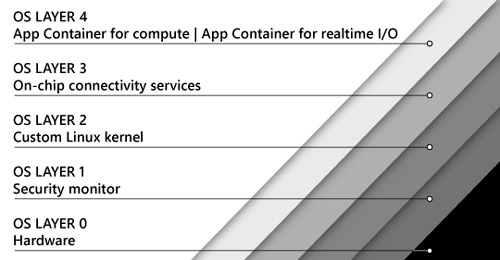 The custom Linux kernel is at OS Layer 2 of Microsoft's forthcoming Azure Sphere OS. (Image source: Microsoft)
The custom Linux kernel is at OS Layer 2 of Microsoft's forthcoming Azure Sphere OS. (Image source: Microsoft)
Microsoft is not conceding defeat here to Linux, with which Windows has fought for decades, but more of a tactical cooperation with the open source community that Microsoft has increasingly worked with for the last several years.
Microsoft is still sprinkling the operating system with Windows features, and recognizing that Linux has a more efficient kernel for the limited devices of IoT.
"This is a new operating system. It's based on a custom Linux kernel -- a custom Linux kernel that has really been optimized for an IoT environment and is reworked with security innovations pioneered in Windows," Smith said. "Of course, we are a Windows company, but what we've recognized is the best solution for a computer of this size in a toy is not a full-blown version of Windows. It is what we are creating here. It is a custom Linux kernel, complemented by the kinds of advances that we have created in Windows itself."
Even with those caveats, this is a significant step for Microsoft. This is a company that always saw Windows as the answer to any operating system question -- from Windows Datacenter Server in the largest use case to the recent Windows IoT Core for the very smallest.
The new days at Microsoft just keep on coming.
Posted by Scott Bekker on April 17, 20180 comments
Fresh from announcing a plan to invest $5 billion in Internet of Things (IoT) initiatives over the next four years, Microsoft this week took its IoT push even further with the launch of a major new security vision.
Brad Smith, Microsoft president and chief legal officer, unveiled Azure Sphere on Monday during a security news briefing in San Francisco timed to coincide with the start of the 2018 RSA Conference. Azure Sphere aims to secure the billions of IoT devices, from device hardware to software to cloud -- and gives Microsoft a central role.
"It is an end-to-end IoT solution. It goes where...no company has gone before," Smith said.
The Azure Sphere solution has three parts: Azure Sphere MCUs, the Azure Sphere OS and the Azure Sphere Security Service.
Azure Sphere MCUs: The first part is a microcontroller unit (MCU), the chips that power IoT devices. Microsoft has developed a new class of MCUs, which it also calls the Azure Sphere MCU or Azure Sphere chip. Microsoft plans to license the intellectual property of the new MCUs royalty-free for silicon partners interested in developing and manufacturing Azure Sphere chips. A major element of the chips is the Microsoft Pluton Security Subsystem for creating a hardware root of trust, storing private keys and executing cryptographic operations. Other elements of the chips include network connectivity, Microsoft I/O firewalls, an application processor, a real-time processor, flash memory, SRAM and multi-plexed IO, according to a diagram.
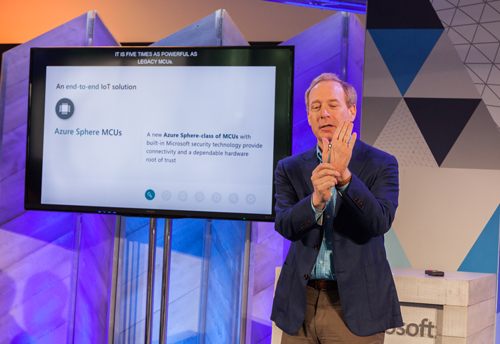 [Click on image for larger view.] Brad Smith, Microsoft president and chief legal officer, holds up a microcontroller unit during a security news briefing in San Francisco. (Image source: Microsoft)
[Click on image for larger view.] Brad Smith, Microsoft president and chief legal officer, holds up a microcontroller unit during a security news briefing in San Francisco. (Image source: Microsoft)
Azure Sphere OS: The second part is an operating system for IoT devices built on a Linux kernel, the first time Microsoft has released an OS built on Linux. According to Microsoft, the Azure Sphere OS will offer a trustworthy, defense-in-depth platform via secured application containers and a security monitor.
Azure Sphere Security Service: The cloud component is the Azure Sphere Security Service, which Microsoft describes as a turnkey cloud security service. Elements include certificate-based authentication for all communication, device authenticity checks, device status and health monitoring, automated updates of the Azure Sphere OS, and device software deployment services. The security protections through the service are designed to last for a 10-year device lifetime.
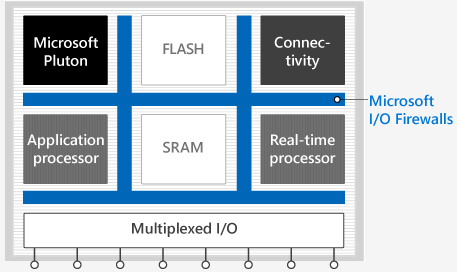 Architectural diagram of the Azure Sphere MCU. (Image source: Microsoft)
Architectural diagram of the Azure Sphere MCU. (Image source: Microsoft)
Currently, Azure Sphere is in a private preview, and Microsoft is working with select hardware providers. The first Azure Sphere chip is being developed by MediaTek Inc., which built the MT3620 as a reference architecture for Azure Sphere with Microsoft and is now sampling the chip with some customers. The company expects broad public availability for the MT3620 in the third quarter of this year.
"MediaTek has a long history of working with Microsoft on specific SoC [system on a chip] designs that meet demanding connectivity needs," said Jerry Yu, MediaTek corporate vice president and general manager of the Intelligent Devices Business Group, in a statement Tuesday. "On top of our close ties with Microsoft and design expertise, Microsoft had a vision we also believed in."
According to a blog by Galen Hunt, partner managing director at Microsoft for Azure Sphere, a first wave of Azure Sphere devices will be "on shelves" by the end of 2018. He also promised universally available dev kits by mid-2018.
Arm Ltd. was also another early partner, working closely with Microsoft to incorporate its Cortex-A application processors into Azure Sphere MCUs, according to a Microsoft page detailing the Azure Sphere silicon ecosystem. Other partners represented on that page include Hilscher, LitePoint, LongSys, Nordic, Nuvoton, NXP, Qualcomm, Seeed Studio, Silicon Labs, ST Micro, Toshiba and VeriSilicon.
During the briefing, Smith suggested why Microsoft thinks the time is right to roll out a significant IoT security initiative.
"There are going to be 9 billion of these MCU-based devices shipped this year. Think about that. For every person on the planet, there will be more than one of these MCU devices shipped. They literally will be in the toys of our children, they literally will be in our kitchens and our refrigerators, they will be in every room in our house," Smith said. "Today, fewer than 1 percent of those MCUs are connected to a network or the Internet. But that is changing, and it's going to continue to change. And what it fundamentally means is that our homes and our offices and the infrastructure of the future will literally be only as secure as the weakest link."
Smith also cited the Mirai botnet as a harbinger of the types of security threats that will become more common as IoT expands, and as a reason that a holistic security approach is needed.
"It was in 2016 that the Mirai attack basically enabled hackers to take control of 100,000 devices and use it to launch a DDoS attack by turning those devices into part of a botnet. It was an attack that, on a single day, basically took the East Coast of the United States off of the Internet," he said, reinforcing an idea that he discussed earlier in his talk and in a related blog post. The idea is that Microsoft and others in the tech sector have the first responsibility to address security issues.
"We operate the platform. We unfortunately are the battlefield in many ways," he said.
Posted by Scott Bekker on April 17, 20180 comments